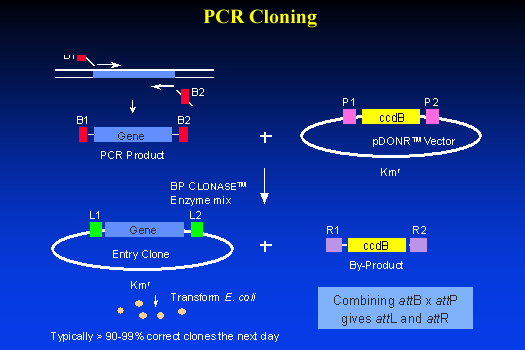
Copy Rights: GATEWAY
online seminar

Copy Rights: GATEWAY
online seminar
The gene of interst can be amplified from the original vector using primers containing recombination sites. The PCR product, flanked by the B1 and B2 recombination sites is mixed in vitro with a Donor vector and BP CLONASE Enzyme Mix. Site specific recombination between the attP site on the pDonor and the attB site on the PCR product generates a co-integrate plasmid which is subsequently resolved into two molecules: one contains the DNA segment of interest in the new vector backbone (Entry Clone) flanked by attL recombination sites, and the other contains the ccdB toxic gene and will not amplify.
Copy Rights: GATEWAY
flyer
 The
gene of interest is now in the Entry Clone.
The
gene of interest is now in the Entry Clone.  This Entry Clone can be used for transfering the gene into a variety of
expression vectors suitable for different expression systems. These expression
vectors are termed "Destination Vectors". Adding the Destination Vector
This Entry Clone can be used for transfering the gene into a variety of
expression vectors suitable for different expression systems. These expression
vectors are termed "Destination Vectors". Adding the Destination Vector  and LR CLONASE Enzyme Mix will cause site-specific recombination between
the attL site
on the Entry Clone and the attR
sites on the Destination vector to generate a co-integrate molecule which
is subsequently resolved into two molecules, one contains the gene of interest
in the new vector backbone (Expression Clone),
and LR CLONASE Enzyme Mix will cause site-specific recombination between
the attL site
on the Entry Clone and the attR
sites on the Destination vector to generate a co-integrate molecule which
is subsequently resolved into two molecules, one contains the gene of interest
in the new vector backbone (Expression Clone), and the other is in the by-product vector,
and the other is in the by-product vector,  containing the ccdB toxic gene that prevents expression in bacteria.
containing the ccdB toxic gene that prevents expression in bacteria.
Summary of the Cloning Procedure

Copy Rights GATEWAY
online seminar